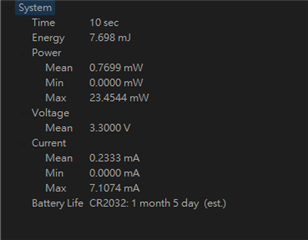Other Parts Discussed in Thread: LP-XDS110, ENERGYTRACE, SYSCONFIG
Tool/software:
We use the data_stream_LP_EM_CC2340R5_freertos_ticlang example to measure power consumption. After turning off the LED and removing the debug IC and external flash from the board, we use an ammeter to measure the power consumption. Before the bluetooth is connected, which is approximately between 150uA and 920uA. And we found that the power consumption of LDO on the board is about 130uA. After deducting the power consumption of LDO, the power consumption of CC2340R5 is about 20uA to 790uA. Is this power consumption normal? If it is abnormal, is there something wrong? Are there any settings that we ignored or need to modify?
By the way, when bluetooth is connected, the power consumption is between 150uA and 500uA. After deducting the power consumption of LDO, the power consumption of CC2340R5 is about 20uA to 370uA.





